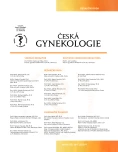Description of diagnosis of 45,X/46,XY ovotesticular DSD
Authors:
Š. Ren; V. Harmaš; M. Stará; Laštůvkováj.; V. Čejnová
Authors‘ workplace:
Oddělení lékařské genetiky, Krajská zdravotní a. s., Masarykova, Ústí nad Labem, vedoucí pracoviště MUDr. V. Harmaš
Published in:
Ceska Gynekol 2020; 85(4): 259-262
Category:
Case Report
Overview
Objective: Description of diagnosis of 45,X/46,XY ovotesticular DSD.
Design: Case report.
Setting: Department of Medical Genetics, KZ a.s., Masaryk Hospital, Ústí nad Labem.
Case report: 45,X/46,XY ovotesticular DSD is a diagnosis, which in this case was detected by chromosomal examination was performed, in which the child showed karyotype 45,X[2]/46,XY[8] – a pathological male karyotype correlated with the syndrome 45,X/46,XY ovotesticular DSD (disorder of sexual development). At the same time, a variant of chromosome 10 : 45,X,inv(10) (p11q21.2)/46,XY,inv(10)(p11q21.2) was detected.
Conclusion: The phenotype of patients with mosaic karyotype 45,X/46,XY ranges in a wide range from the female phenotype with classical Turner syndrome, through individuals with ambiguous genitals to normal but infertile men. Thus, both Turner‘s syndrome and virilization can be expected. Gonads are usually dysgenetic with insufficiently differentiated testicular tissue, which can occur in both gonads (mixed gonadal dysgenesis) or only in one (asymmetric gonadal dysgenesis). With this type of gonadal dysgenesis, there is a risk of gonadoblastoma or other tumors.
Keywords:
Genetics – 45,X/46,XY – ovotesticular – DSD – Turner syndrome – sex development
Sources
1. Barthold, JS., Gonzalez, R. Intersex states. In: Gonzales, ET., Bauer, SB., eds. Pediatric Urology Practice. Philadelphia: Lippincott Williams & Wilkins; 1999.
2. Fleming, A., Vilain, E. The endless quest for sex determination genes. Clin Genet, 2004, 67, p. 15–25.
3. Gardner McKinlay, RJM. Chromosome abnormalities and genetic counseling. 5. vydání. Oxford University Press, 2018.
4. Konrádová, V., Uhlík, J., Vajner, L. Funkční histologie. 2. vydání. Jinočany: H & H, 2000, 291, s. 209.
5. Lebl, J., Janda, J., Pohunek, P., et al. Klinická pediatrie.1. vydání. Praha: Galén, 2012, s. 203–207.
6. Lebl, J., Janda, J., Pohunek, P., et al. Praktická pediatrie: Obvyklé diagnostické a léčebné postupy na Pediatrické klinice v Motole. 1. vydání. Praha: Galén, 2008, s. 153–158.
7. Moore, KL., Persaud, TVN. Zrození člověka: Embryologie s klinickým zaměřením. 1. vydání. 2000. 564 s.
8. Sadler, TW. Langmanova lékařská embryologie. 1. vydání. Praha: Grada, 2011, 432 s.
9. Šípek, A. Genetika – Turnerův syndrom. Genetika, 2007 [cit. 2009 - 05-29]. Dostupné z: https://web.archive.org/web/20160422123809/ http://genetika.wz.cz:80/clanky/turneruv_syndrom.php
10. Šnajderová, M., Vavřinec, J. Poruchy sexuální diferenciace a sexuálního vývoje z pohledu dětského endokrinologa. Česká společnost pro sexuální medicínu, 2010 [cit. 2010-09-02]. Dostupné z: http://www.cssmweb.cz/news/poruchy-sexualni-diferenciace-a - -sexualniho-vyvoje-z-pohledu-detskeho-endokrynologa/
Labels
Paediatric gynaecology Gynaecology and obstetrics Reproduction medicineArticle was published in
Czech Gynaecology

2020 Issue 4
Most read in this issue
- Cesarean scar defect – manifestation, diagnostics, treatment
- What next in cervical cancer screening?
- Assisted reproductive methods – current status and perspectives
- Benefits of exercise in the prenatal and postnatal period
